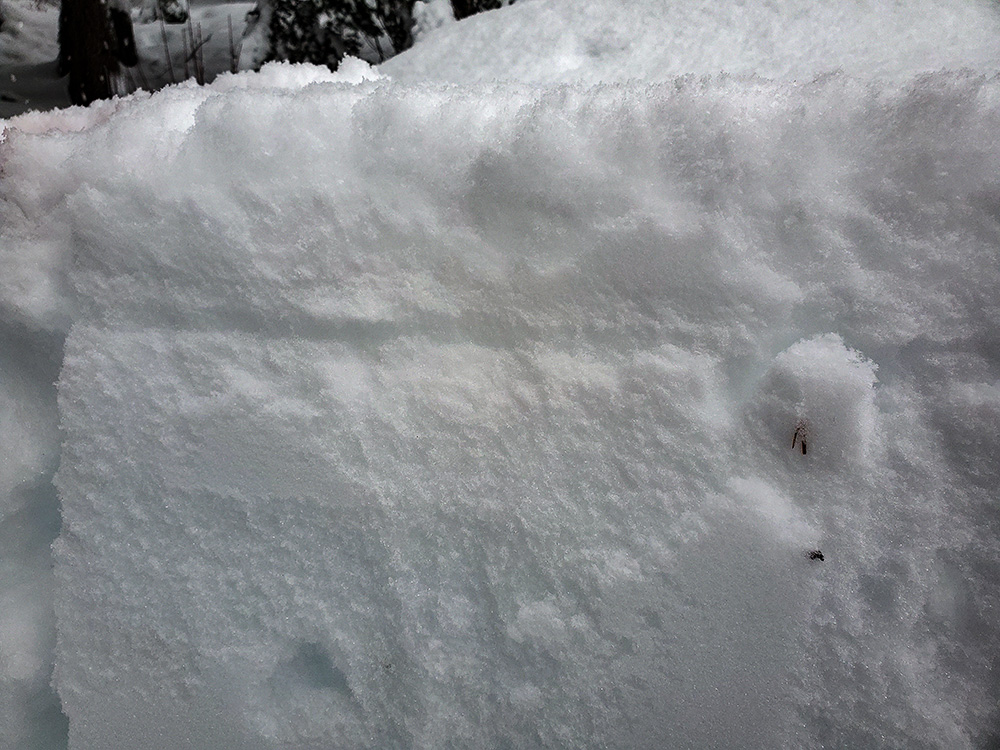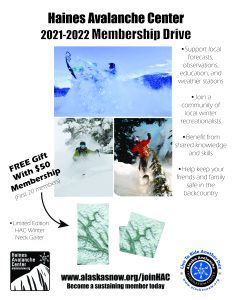Haines Avalanche Center
Above 2,500ftModerate
1,500 to 2,500ftModerate
Below 1,500ftModerate
Degrees of Avalanche Danger
Avalanche Problems
Problem 1
Aspect: Most likely on SW-S-SE-E-NE
Elevation: Most likely Above Treeline and Near Treeline
The Bottom Line: Extreme arctic outflow has blasted the slopes for the last 6 days. Wind loading has slowed down now that there is less snow available for wind transport. But…recently wind loaded areas are still harboring layers of slab that are possible to be triggered by a human. Avoid stiff wind slab in specific areas prone to slide, such as be wind loaded rollovers, chutes, and gullies steeper than 30 degrees.
Another note: Some very large cornices have formed on SW, S, and SE aspects. As always, be sure to give cornices the proper respect: stay WAY back. When they fail, they always break further back than you would expect.
Travel Advice: Watch for red flags (shooting cracks, collapsing or recent natural avalanche activity). Stay away from slopes below top loaded ridgelines, roll-overs, or cross loaded gullies and other features steep enough to slide >30 degrees. Look for stiff, hallow, dense, drum-like slabs. Avoid terrain traps where snow could pile up quickly, or the consequences of a slide could cause injury or death.
Note: Surface avalanches could step down to weaker buried layers, see Persistent Slab problem.
Likelihood:
- Almost Certain
- Very Likely
- Likely
- Possible
- Unlikely
Size:
- Historic
- Very Large
- Large
- Small
Trend
- Increasing
- Steady
- Decreasing
Problem 2
Aspect: Mainly on wind-protected and wind loaded slopes, most likely beneath terrain features on S, SE, and E aspects
Elevation: All elevations, mainly at and above treeline.
Bottom Line: Small surface wind slabs could step down to deeper slabs that have wide propagation. Identify and avoid features of concern, such as trigger points, sheltered slopes, thin areas in the snowpack and steep wind loaded slopes below terrain features.
Travel advice: Consider any possible slopes harboring buried surface hoar, or other weak snow as guilty until proven innocent. Always use safe travel techniques such as only exposing one person at a time both on the way up and down. Identify and avoid thin areas where weak layers are more likely to trigger a slide from. Group up in safe zones that are out of harms way. Have good communication, including radios and a set plan in case of an emergency. Be practiced at companion rescue..
The persistent slab danger is not going away, it is standing by waiting for the right trigger. We have not had a crush and flush cycle, or stabilizing event.
- Surface hoar from Dec 18th may have been preserved in wind-protected areas. It is now buried by about a foot of snow.
- Recent observations from Old Faithful found a thin crust with weak snow down 60-70cm near 3,200′ and below
- This bathtub ring effect, from lower-elevations to mid-elevation, where freezing levels are more likely to cause crusts and weak layers – should be carefully evaluated.
- Weaker snow (buried facets) forming between wind slabs in the top of the pack
It is still possible that any surface avalanches could step down to deeper weak layers, the October rain crust, or even the ground in alpine areas.

Buried surface hoar layer (thin grey line) in an opening below treeline in the Transitional zone. This layer is now about 12″ deep. It exists in isolated wind protected areas.
Likelihood:
- Almost Certain
- Very Likely
- Likely
- Possible
- Unlikely
Size:
- Historic
- Very Large
- Large
- Small
Trend
- Increasing
- Steady
- Decreasing
Avalanche Activity
This natural avalanche occurred on Dec 12th on Old Faithful during a wind event. It ran on a cross-loaded NE aspect at 3200ft, running on the October rain crust. It shows that given a heavy new load, this persistent weak layer can activate and cause a large avalanche.

Weather
Cold arctic outflow continues with temperatures and wind easing slightly Friday. However, this weekend brings a major pattern change starting Saturday. This will bring heavy precip and rapid warming by Sunday night. The most likely scenario is 12-16″ of new snow in the valleys (turning to rain Sunday night), with 24″ of snow possible above 1000ft.
- Very strong NW winds and arctic temperatures blasted the area the first week of January
- Jan 1st: New snow (20″ in Lutak, 7″ Transitional zone) buried any preserved surface hoar.
- Moderate NW winds hit exposed slopes Dec 19-20th
- Surface hoar formed on all aspects and elevations Dec 17-18th
- December brought in about 2-5 feet of snowfall (highest in Lutak zone), and a few strong NW wind events
- November brought consistent heavy snowfalls, cold weather, and SE winds
- October brought heavy snow in the alpine, followed by a few rain/sun crusts
| Snow Depth [in] | Last 24-hr Snow/SWE [in] | Last 3-days Snow/SWE [in] | Today’s Freezing Level [ft] | Today’s Winds | Next 24-hr Snow/SWE | |
| Mount Ripinsky @ treeline ** | 80″* | 0″ / 0.00* | 0″ / 0.00* | 0′ | mod, NW | 0″ / 0.00* |
| Flower Mountain @ treeline | 43″ | 0″ / 0.00 | 0″ / 0.00 | 0′ | mod, N | 0″ / 0.00* |
| Chilkat Pass @ 3,100ft | 14″ | 0″ / 0.00 | 0″ / 0.00 | 0′ | mod,N | 0″ / 0.00* |
( *star means meteorological estimate )
** The Ripinsky weather station is in need of repair, and will likely be down until Summer.
Additional Information
Ride rescue ready. Be prepared for an emergency. Prevent hypothermia. Carry bear spray. Winter is a high consequence environment.
Become a sustaining Haines Avalanche Center Member by clicking the poster or visiting alaskasnow.org/joinHAC. Support local forecasts, observations, education and weather stations. Join a community of winter recreationalists. Benefit from collective knowledge and skills. Help keep your friends and family safe in the backcountry. Get a free limited edition mountain buff, or neck gaiter with a $50 membership (first 20 members!).
Practice like you play. Make sure all your rescue gear is fully functional and your beacon has NEW batteries. Make sure 1) everyone in the group has a functioning beacon, shovel and probe 2) knows how to use them and 3) has trained in companion rescue in the last year. Keep your skills fresh. If you head into the hills, watch out for red flag avalanche conditions, natural avalanches, whoomphing or collapsing, and shooting cracks.
Education Video Links:
- AIARE
- How to Practice Avalanche Rescue Snowmobile Edition: https://youtu.be/2ML499MMDfM
- AK Sled Shed Motorized Learning:
- Intro: https://youtu.be/aoagKHfGkxs
- Personal Electronics in Avalanche Terrain: https://youtu.be/2Vz9S0OEyFk
- Snowmobile Macgyver Tool Kit: https://youtu.be/4WBNu_t6Bbk
- Head and Face Protection: https://youtu.be/jIzW89wOyZI
- Pre-season prep: https://youtu.be/zJmrb8cZlR4
- My Transceiver: https://youtu.be/yblaDWP7Jf8
- BCA Avalanche Safety for Snowmobilers
- How to Fix Common Snowmobile Problems in the Field: https://youtu.be/g9fiTxEvuFk
- Sleducation: Avalanche Safety for Snowmobilers: https://youtu.be/EWFOd_9DYb8
- Intro to Avalanche Transceivers for Snowmobilers: https://youtu.be/6ZLSBmsceog
- Avalanche Transceiver Trailhead Test for Snowmobilers: https://youtu.be/rWoXbadFBsY
- Avalanche Transceiver Searching Use Snowmobiles: https://youtu.be/w1ucyI6LMXM
- BCA Avalanche Rescue Series
- Beacon Search 101: https://youtu.be/nnHXLVA2FcE
- Avalanche Probing 101: https://youtu.be/-0_yDN5Drzw
- Avalanche Shoveling 101: https://youtu.be/dGQg9o3vAkM
- Organizing a Backcountry Rescue: https://youtu.be/gywtmukgt8s
- Post Avalanche Patient Care: https://youtu.be/9FyIeUy4wpQ
- Backcountry Evacuation: https://youtu.be/WPF-dciefL8
- Complex Multiple Burials Backup Techniques: https://youtu.be/pB6AfY2KyYo
- National Avalanche Center
- Avalanche Problems Explained: https://youtu.be/DkbnT_9-cHU
- Intro to North American Avalanche Danger Scale: https://youtu.be/r_-KpOu7tbA
Announcements
Bottom Line: A big weather pattern shift occurs beginning Saturday, stay tuned! Identify and avoid terrain trap areas that can multiply consequences with the recent snow load and combined winds. Be on the lookout for signs of instability such as hollow sounds, shooting cracks, and whumphing. Isolated wind-protected and wind loaded slopes are likely to harbor deeper weak layers (including surface hoar, depth hoar, and crust facets) with step down potential. Click the –Full Forecast– button below for more details. Please submit your observations!


